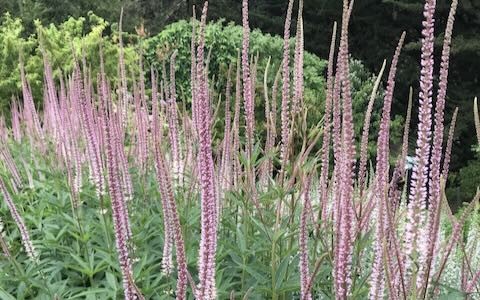
Hydrangea petiolaris
Japanese woodland species with climbing habit. Prefers drained peaty soil and sun protection, ideal for southern wall or trellis.


A handsome plant with attractive palmate foliage on straight stems, topped with 30 cm spikes of pale pink Veronica flowers. Best in a moist fertile spot.
A handsome plant with attractive palmate foliage on straight stems, topped with 30 cm spikes of pale pink Veronica flowers. Best in a moist fertile spot.
Data sheet
Japanese woodland species with climbing habit. Prefers drained peaty soil and sun protection, ideal for southern wall or trellis.
Low mounding plant with silvery finely cut foliage and white daisies. Native to Sicily, extremely drought tolerant avoid over watering and wet areas. Cut back occasionally after flowering.
The orange oriental perennial poppy, originally from Turkey. The blooms are impressive, and in good conditions the plant will make a large perennial clump in only a few years. Remove the first flower and avoid acid soils.
An interesting variety that begins white with a blue eye, then fades to a soft pink as the flowers age. As with other asters, strong and reliably flowering late summer. Upright bushy non collapsing habit.
An upright form with large florets and strong stems, much favoured by flower arrangers for its prolific habit. Distinctive from other varieties because of its larger than usual flowers.
Shorter growing variety often more suited to smaller spaces and cottage gardens than taller Helenium 'Moerheim Beauty'. Only knee high and combines well with sunny border foreground plantings of dianthus, geraniums and Salvia nemorosa.
Attractive mauve colour distinct from the usual pinks and blues, cultivation as per other nemorosa varieties, will repeat flower on good soil if trimmed hard after first flowering.
Lush leafy perennial for fertile clay soils, larger and more bushy in habit than Filipendula rubra with white flowers. Plant with gunnera, Lysimachia cletheroides and Iris siberica around ponds and water features.
White form of Echinacea purpurea with attractive seedheads after flowering. Prolific and beautiful.
A wild Paeonia from the Caucasus from Ukraine to Romania with deep tomato red flowers and finely dissected foliage. This is a dwarf species which prefers fertile but drained conditions, and needs to dry off in summer after the growing period. A rare treasure.
Heleniums are the mainstay of summer togeather with miscanthus, sedums and perovskia. They need virtually no water and put on a great display in our border despite being completely neglected. This is the wild occurring yellow flowered form.
The best red monarda; mildew resistant and tough as they come. Like all monarda, these grow best on fertile clay loam or well mulched moisture retentive soil types.
Purple foliage plant with white flowers, for clay soils or wet areas, much loved by flower arrangers. Creates good foliage infill where needed.
Old fashioned variety from Dennis Norgate with double red fragrant flowers, strong bushy grower with long enough stems to pick, without being fragile like many of the modern carnation varieties.
Brilliant new variety with dark foliage ; strength and upright growth habit of 'Matrona' but the darker foliage of 'Purple Emperor' and red flowers.
Silvery succulent, ideal in dry and exposed conditions including coastal situations. Flowers are coral pink during winter and the bushy form of this variety associates well with Stipa gigantea, aeoniums, fascicularia, and sedums.

A handsome plant with attractive palmate foliage on straight stems, topped with 30 cm spikes of pale pink Veronica flowers. Best in a moist fertile spot.